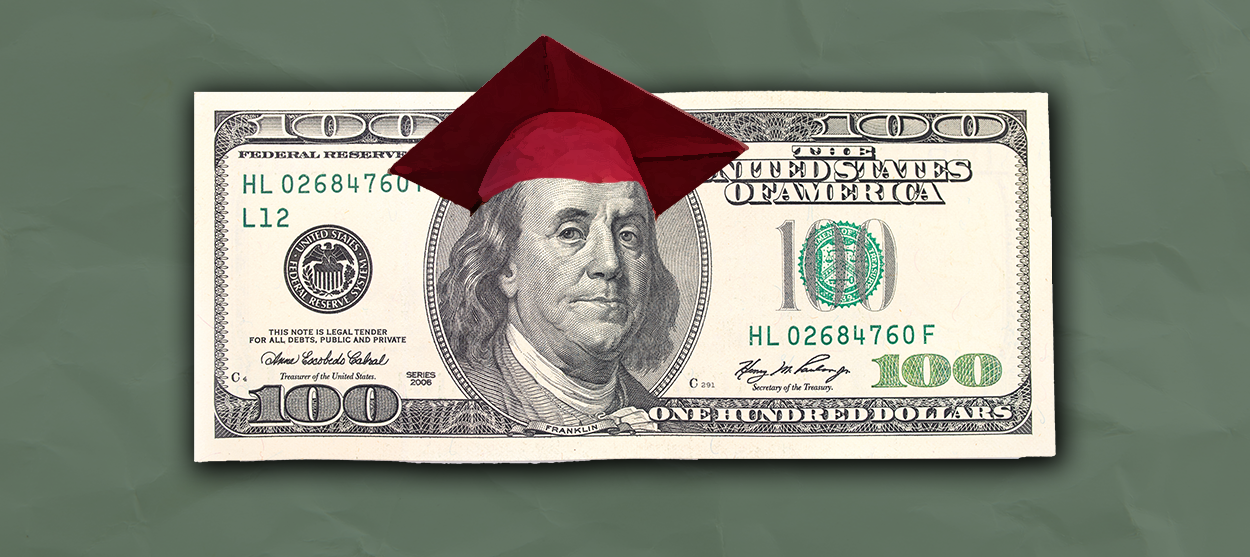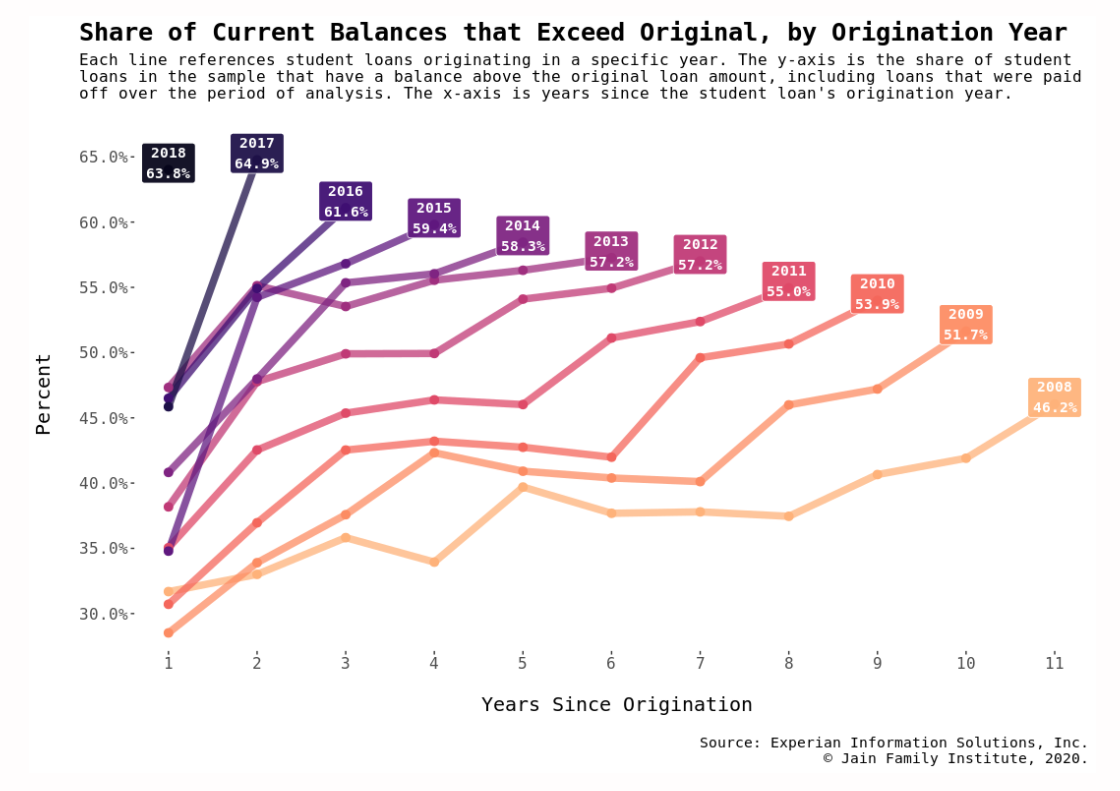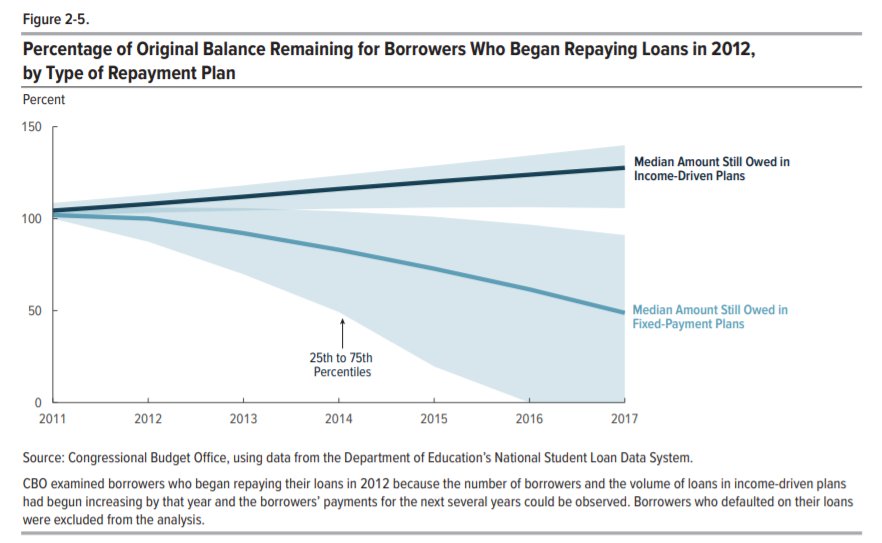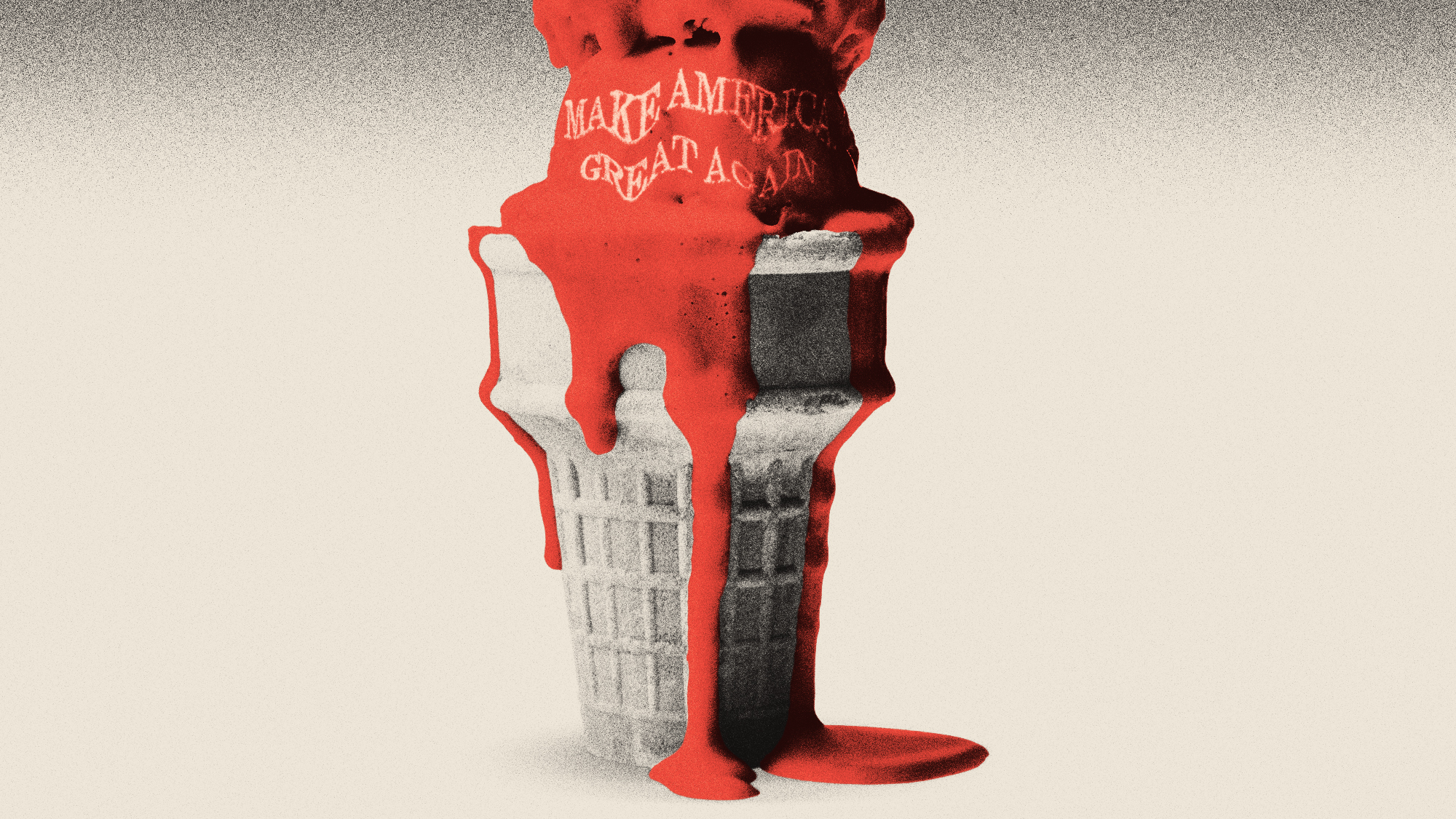The secret truth of the student debt crisis
Most student loans issued today are never going to be paid off


The student debt crisis has gotten wide attention over the last several years. Democratic Sens. Elizabeth Warren and Chuck Schumer have called for canceling $50,000 in student debt for each borrower, while others have argued this would be unfair because college graduates generally make more money than the average.
The truth is the question of whether student debt should be canceled is largely irrelevant. Most student debt will be canceled sooner or later, because an ever-growing share of borrowers cannot possibly repay their loans. Ever. The only question that matters is whether President Biden and Democrats in Congress can grapple with reality and fix America's colossally stupid system of funding higher education.
Economist Marshall Steinbaum has been studying the structure of student loans in detail, and produced some eye-popping results. The headline fact from his most recent study is that a large fraction of borrowers are not making any progress on paying off their loans, and that fraction has grown steadily over time. This chart shows the percentage of student loan accounts that had increasing balances over the period from 2008-2019.
The Week
Escape your echo chamber. Get the facts behind the news, plus analysis from multiple perspectives.

Sign up for The Week's Free Newsletters
From our morning news briefing to a weekly Good News Newsletter, get the best of The Week delivered directly to your inbox.
From our morning news briefing to a weekly Good News Newsletter, get the best of The Week delivered directly to your inbox.

(Courtesy Jain Family Institute)
Two things immediately jump out: First, the fraction of student loans with an increasing balance steadily grew for all loans. For loans issued in 2008, the next year less than 30 percent of them had an increased balance — but in 2019, 46.2 percent of them did. Second, the problem is getting worse. Each year a greater share of loans started out with increasing balances, and by 2018 almost two-thirds of them were like that. (Note also there is a kink at 2016 in which increasing balances start rising strongly, I will return to that later.)
As Steinbaum writes, student debt is like a bathtub that is overflowing because too much debt is pouring in and not enough is being paid off. Loans are getting steadily older over time, because more and more are not being paid off (in 2019, over 22 percent of loans were more than 10 years old, which is the entire traditional repayment period), and a much greater share of borrowers are making tiny or no payments. There is also a marked racial bias — the share of loans in majority-minority zip codes with rising balances was 61.6 percent, as compared to 49.5 percent in majority-white ones.
The roots of the crisis go back decades. Public colleges and universities used to be very cheap for students, funded mostly by land grants and state subsidies. But starting in the 1970s during the neoliberal turn, families and students started shouldering more and more of the burden — paying high tuition often funded through loans, which were subsidized by the federal government. Both schools and students started thinking about higher education as a business proposition. More and more institutions charged as much as they possibly could in tuition, while many students came to think of high prices as being an indicator of quality (after all, you get what you pay for).
A free daily email with the biggest news stories of the day – and the best features from TheWeek.com
Instead of providing a good education at a reasonable price, colleges and universities became more like country clubs, hiring ever-more administrators with ill-defined jobs and stocking themselves up with incredibly fancy amenities.
The trend accelerated after 2008, when state tax revenues cratered during the recession, and most state governments slashed higher education funding to compensate. Meanwhile, the weak ensuing recovery meant that a higher education credential was a practical requirement to get a job in many fields, and so more and more people piled into schools. Those facts were part of the reason why Democrats nationalized most student debt as part of the ObamaCare law in 2010, cutting out some of the private sector middlemen who had soaked student loan borrowers with high fees. Today Uncle Sam owns about 95 percent of all student loans.
But this did not solve the problem of skyrocketing college costs. Instead prices kept rising and rising, funded by ever-greater borrowing — between 2010 and 2020, the total of outstanding student debt increased from $828 billion to $1.691 trillion. Meanwhile wages, which are the only source of money to pay off loans for the vast majority of people, remained largely stagnant. As a result, the number of people struggling to make progress on repayment or falling into outright default started to rise.
That brings me back to the kink I mentioned in the chart above. The looming repayment crisis inspired the Obama administration to set up an income-driven repayment (IDR) scheme, which was expanded several times, particularly in 2016. This allowed distressed borrowers to pay only a set fraction of their income, and theoretically after a number of years or doing certain public service tasks, get the loan forgiven (though few have actually been approved so far). Now, IDR is a great help to many people who saw their payments reduced, but it also meant that most of them were not paying enough to make progress on eroding their debt's principal — thus the ballooning debt balances we've seen. This chart from the Congressional Budget Office (also cited by Steinbaum) shows that, on average, borrowers in IDR have seen their loan balances increase steadily:

(Courtesy Congressional Budget Office)
Effectively, the IDR program (whose enrollment has grown steadily to about a fifth of borrowers) is a tacit admission that most student loans are never going to be paid off in full. Those who have not enrolled have seen far higher rates of default; on current trends most borrowers will be in IDR eventually, which is rapidly becoming a kind of ad hoc bankruptcy program for student borrowers. In a sense, the U.S. is starting to fund its higher education system with a payroll tax on people who go to college but are too poor to pay for it out of pocket — except we then force them to sit under an enormous load of basically imaginary debt for decades while doing it. This damages their credit, making it harder to get a job, a house, a car, and so on.
It's easy to imagine a solution for this problem. Simply get rid of the debt, most of which is not going to be paid back anyhow, and in future finance public higher education directly. Then use that leverage to force schools to get their costs under control. The most logical payment method would be ordinary progressive taxes, but even an actual graduate tax would be fairer than the current system — at least people would not have the debt burden, and graduates from rich families wouldn't be able to skate by having their parents pay up front.
But this would require facing some unpleasant truths. At The Wall Street Journal, Josh Mitchell reports that former Secretary of Education Betsy DeVos commissioned a report on the student loan portfolio from a private banker, who found the Department of Education had been using very unrealistic assumptions about how much it was likely to make on its loan portfolio. Indeed, the report, which focused on defaulted loans, was if anything not pessimistic enough, because most student loans are not in default. "I'm very confident in saying the government is underestimating how much debt can't be repaid, and thus the whole portfolio looks way too rosy," Steinbaum told The Week.
This happened because the student loans were thought to be a way for the government to make money. As Mitchell writes, in the 1990s and 2000s lawmakers raised limits on loans and allowed parents to take on student debt partly because future revenues projected by the Congressional Budget Office meant the measures could be justified as deficit control. A deficit-reducing CBO score "is a key factor in deciding whether a policy is adopted or not," Robert Shireman, who worked on several of these laws, told Mitchell. "The fact that it saved money helps enact it."
Except it didn't actually save money. It just inflated a huge bubble of student debt on the backs of people who did not make the higher wages lawmakers anticipated in their future plans, and the government will have to eat the losses at some point. Now the state's own actions have ensured that debt will never be paid back in full.
Mitchell frames the problem through worries that "taxpayers could ultimately be on the hook for roughly a third of the $1.6 trillion federal student loan portfolio." It is true that facing reality will, other things equal, reduce future government revenues. But this is not really a problem for taxpayers — the debt is already bad, and the government could just write it off (Biden could arguably do this via executive action). The extra revenue required could easily be borrowed, or made up with a modest tax hike on the rich. The vast majority of Americans would not be affected at all.
But there are signs that the Biden administration is already falling back into the deficit-phobic mindset that helped create this problem in the first place. David Dayen reports at The American Prospect that Biden is determined to pay for his infrastructure and welfare programs, with Treasury Secretary Janet Yellen leading the push. As Alex Pareene writes at The New Republic, "it's the zombie worldview that threatens any chance of this government averting a multitude of political, economic, and ecological disasters."
When it comes to any potential student loan reforms then, it will probably be tempting for the Biden administration to try to trick the CBO by not recognizing the inevitable losses on its portfolio, so it doesn't have to find further pay-fors. Indeed, as Rachel Cohen reports at The Intercept, liberal think tanks have already outlined a plan to end the student loan repayment pause by enrolling more borrowers in IDR. But "that doesn't solve the problem of people not repaying debt, and in fact it makes it worse," Steinbaum says.
What has happened with higher education bears a marked resemblance to what has happened in health care over the last several decades. In each case the government has shoveled ever-greater indirect subsidies into a greedy and often outright predatory sector, which gobbled up the subsidies with ever-higher prices. Now that the system is breaking down, the government faces the option of admitting its mistake and trying to set up a rational, efficient system, or sweeping the problem under the rug. I am not at all confident the Biden administration will make the right choice.
Ryan Cooper is a national correspondent at TheWeek.com. His work has appeared in the Washington Monthly, The New Republic, and the Washington Post.
-
 Is MAGA melting down?
Is MAGA melting down?Today's Big Question Candace Owens, Tucker Carlson, Laura Loomer and more are feuding
-
 Kushner drops Trump hotel project in Serbia
Kushner drops Trump hotel project in SerbiaSpeed Read Affinity Partners pulled out of a deal to finance a Trump-branded development in Belgrade
-
 Son arrested over killing of Rob and Michele Reiner
Son arrested over killing of Rob and Michele ReinerSpeed Read Nick, the 32-year-old son of Hollywood director Rob Reiner, has been booked for the murder of his parents
-
 Has Zohran Mamdani shown the Democrats how to win again?
Has Zohran Mamdani shown the Democrats how to win again?Today’s Big Question New York City mayoral election touted as victory for left-wing populists but moderate centrist wins elsewhere present more complex path for Democratic Party
-
 Millions turn out for anti-Trump ‘No Kings’ rallies
Millions turn out for anti-Trump ‘No Kings’ ralliesSpeed Read An estimated 7 million people participated, 2 million more than at the first ‘No Kings’ protest in June
-
 Ghislaine Maxwell: angling for a Trump pardon
Ghislaine Maxwell: angling for a Trump pardonTalking Point Convicted sex trafficker's testimony could shed new light on president's links to Jeffrey Epstein
-
 The last words and final moments of 40 presidents
The last words and final moments of 40 presidentsThe Explainer Some are eloquent quotes worthy of the holders of the highest office in the nation, and others... aren't
-
 The JFK files: the truth at last?
The JFK files: the truth at last?In The Spotlight More than 64,000 previously classified documents relating the 1963 assassination of John F. Kennedy have been released by the Trump administration
-
 'Seriously, not literally': how should the world take Donald Trump?
'Seriously, not literally': how should the world take Donald Trump?Today's big question White House rhetoric and reality look likely to become increasingly blurred
-
 Will Trump's 'madman' strategy pay off?
Will Trump's 'madman' strategy pay off?Today's Big Question Incoming US president likes to seem unpredictable but, this time round, world leaders could be wise to his playbook
-
 Democrats vs. Republicans: who are US billionaires backing?
Democrats vs. Republicans: who are US billionaires backing?The Explainer Younger tech titans join 'boys' club throwing money and support' behind President Trump, while older plutocrats quietly rebuke new administration
